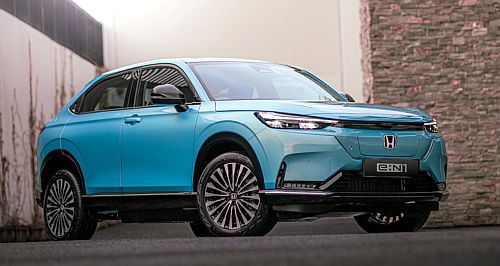Make / Model Search
News - HondaHonda Australia to launch first BEV next yearNow Honda Australia has committed to BEVs, will the e:N1 be first cab off the rank?5 Aug 2025 By TONY O'KANE DESPITE debuting its first all-electric production car half a decade ago (the Europe-focused Honda E compact hatch), Honda has not displayed any urgency in its efforts to bring a battery electric vehicle (BEV) to Australia, only giving a loose timeline of “before 2028” for its first electric vehicle.
But speaking to the media at a business briefing in Melbourne last week, Honda Australia’s recently arrived CEO Jay Joseph confirmed that the brand will finally enter the BEV segment in the second half of 2026.
“For autos, one of the ways to achieve carbon neutral is to transition people’s relationship with energy for mobility, the near-term pathway is electrifying, and that means BEVs.” he said.
“Towards the second half of next year – I can’t provide details but towards the end of this year we’ll share some more – we’ll be launching our first battery electric vehicle on the market.
That vehicle is likely to be the Honda e:N1, also known as the e:Ny1 in Europe and the e:NS1 in China.
Available overseas since 2023, and having just gone on sale in New Zealand in May this year, the e:N1 is, in essence, an all-electric subspecies of the HR-V compact crossover that takes the familiar bodyshell of the HR-V, and wraps it over Honda’s BEV-specific e:N F platform.
Energy comes from a 69kWh battery pack and is deployed by a 260kW/310Nm electric motor driving the front wheels, with a WLTP range claim of 412km.
Inside, a gigantic 15.1-inch portrait-format infotainment screen and a reshaped centre console are the biggest departures from the HR-V’s interior design.
Honda Australia is yet to confirm if the e:N1 is indeed its 2026 BEV, but its recent arrival in New Zealand certainly points toward that.
If so, the Kiwi pricing model for the highly specified e:N1 suggests it could be priced competitively in Australia, with the car’s $NZ52,000 sticker translating into $A47,500 at the current exchange rate.
But from a macro point of view, Honda’s decarbonisation strategy is not stopping with a single BEV, or even multiple. Like Toyota and Hyundai, Honda will continue to look in hydrogen’s direction as the means to achieving its goal of carbon neutrality by 2050.
“When (Toshihiro Mibe) became our global CEO four years ago, the very first thing he said was, if we reduce our emissions by half every year from now to 2050 that won't be enough,” explained Mr Joseph.
“We'll still have emissions. The target has to be zero, and that changed our thinking. And the point I want to make with that is also that BEVs are not the goal – better electric vehicles are a pathway to achieving carbon neutral, but not necessarily the only pathway.
“BEVs will continue to improve. We're working on solid state batteries, but our goal is carbon neutral, not battery electric vehicles. That’s just the obvious pathway in the near-to-mid-term, but we’ll develop other technologies that help achieve that as well.”  Read more |
Click to shareHonda articlesResearch Honda Motor industry news |












Facebook Twitter Instagram